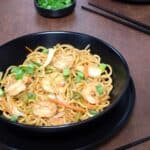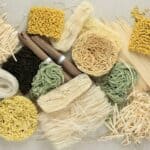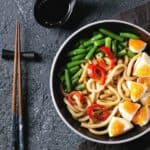For centuries, curries have been a popular dish in Southeast Asia, particularly in Thailand. Combining spices, herbs, and rich flavors makes Thai curries distinct and delightful. The three most popular types of Thai curry are green, red, and yellow. While they share some similar ingredients and cooking processes, each has unique taste characteristics, ingredients list, and heat level that sets it apart.
And if you love curry dishes, I hope you'd give some of my fan-favorite recipes like this Chickpea and Tofu in Red Curry Sauce, Filipino Chicken Curry, Chicken and Vegetables in Red Curry Sauce, and Butternut Squash and Chickpea Tofu. To learn about the shelf-life of squash, be sure to check out my blog about how to tell if a squash is bad.
Now, let’s delve into Thai curries and understand the differences between green, red, and yellow curry, the base ingredients used, their traditional uses, and how to decide which one to use in your dish.
Jump to:
What Is Green Curry
Thai green curry, or 'Gaeng Keo Wahn,' is made from a paste of fresh green chilies, coriander root, kaffir lime zest, and Thai basil, among other ingredients. This curry has a bright color and a fiery heat, which comes from the fresh green chilies used as the main ingredient. The base ingredients for green curry paste include shrimp paste, coriander seeds, cumin seeds, and lime leaves. Coconut milk is also an important part of Thai green curry, giving it a creamy texture and a subtle sweetness that balances the spice.
Traditional Thai and modern chefs use green curry in various dishes, including fish stews, chicken dishes, and vegetable stir-fries. The spice level can be adjusted by varying the number of chilies used. For example, my version of Chickpea and Tofu could be modified using green curry instead of red curry paste for a different taste and heat level.
What Is Red Curry
Thai red curry, or 'Gaeng Phet Daeng,' is made with red curry paste, which consists of dried red chilies, shrimp paste, coriander seeds, and cilantro root. The dried red chilies give the curry a deep red color and a distinct flavor. Red curry paste also contains fish sauce, adding a savory depth to the dishes. Thai red curry is typically made with meat and vegetables, such as chicken or beef. The added benefit of red curry is that it can be customized to your preference. Use fewer red chilies or add more coconut milk for a less spicy curry. Use more red chilies and less coconut milk for a more intense flavor and heat.
My version of Chicken and Vegetables in Red Curry Sauce is a great example of using red curry paste in your cooking. Combining chicken, vegetables, and red curry sauce creates a flavorful, spicy, and satisfying dish.
What is Yellow Curry
In Thai, yellow curry, known as 'Nam Prik Gaeng Karee', is made from yellow curry paste containing yellow chilies, fresh turmeric, curry powder, and sometimes tomato sauce. The yellow color comes from the fresh turmeric and yellow chilies used in the paste. This curry is milder compared to the red and green curries and has a subtle sweetness from the added coconut milk. Yellow curry paste also contains fish sauce, lime juice, and sometimes a hint of sugar.
Thai yellow curry is often made with chicken or shrimp and is served with jasmine rice. The addition of potatoes and onions in the curry gives it a hearty and comforting texture. Try my Filipino Chicken Curry or Butternut Squash and Chickpea Curry version, and consider substituting it with yellow curry paste for a different flavor profile.
Other Types of Thai Curry
Apart from the main types of Thai curries mentioned above, there are other kinds of curry pastes and curry dishes in Thai cuisine. For example, Massaman, Penang (or Panang), and sour curry paste. These curry pastes have different taste characteristics and ingredients that make them unique. Massaman curry, for instance, is made with Massaman curry paste, which contains peanuts, cinnamon, and nutmeg, giving it a sweeter and nuttier flavor than other Thai curries.
Choosing The Right Curry
The best way to know which curry to use in your dish is to understand the flavors of Thai curry and the main ingredients of your dish. For instance, green curry might be a good choice for making a dish with many vegetables because of its fresh herbs and bright flavor. If you are making a meat dish, red curry could be a good fit because of its deeper flavor and spicy heat. For a milder and sweeter curry, yellow curry is an excellent choice.
To sum up, the main difference between green, red, and yellow curry lies in the color of the chilies used, the spice level, and the ingredients used in the curry paste. Each curry has a distinct flavor and heat level, making it suitable for different dishes and tastes. Whether you are dining at Thai restaurants, cooking Thai food at home, or experimenting with my curry recipes, understanding the differences between the main types of Thai curries will help you create delicious and satisfying dishes.
Remember, the key to a great curry dish lies in the balance of flavors, the freshness of the ingredients, and the cooking process. So, don’t be afraid to experiment with different types of Thai curry and find the one that best suits your taste buds!

FAQ
Green curry gets its vibrant hue from fresh green chilies, which are the star ingredient of this spicy delight. Along with its signature color, it boasts a unique blend of flavors derived from herbs like basil leaves, cilantro stems, kaffir lime zest, galangal (a relative of ginger), garlic cloves, and shallots. This combination creates an invigorating balance between spiciness and herbal freshness—a true treat for your taste buds!
Red curry is named after the dried red chili peppers used as its primary flavoring agent—giving it a rich, reddish hue that will catch your eye immediately! It has a slightly less intense spiciness compared to green curry but compensates with complex layers of sweetness thanks to ingredients like lemongrass stalks, galangal or ginger roots, garlic cloves, shallots, or onions, along with an assortment of aromatic spices such as coriander seeds and cumin.
Yellow curry brings sunshine to your plate with its warm, golden appearance! Turmeric is responsible for this radiant color while lending a mild, earthy flavor that distinguishes it from its green and red counterparts. Unlike other curries, which rely heavily on fresh herbs for their aroma profile, yellow curries typically feature turmeric powder alongside spices like cinnamon, cumin, and cardamom. This combination creates a mellow yet delightful flavor that pairs perfectly with vegetables, chicken, or seafood.
While all three curries can offer a kick of spiciness, the intensity levels may differ. Generally speaking, green curry tends to be the hottest of the trio due to its generous use of fresh green chilies.
Other Curry Dishes
Looking for other recipes that use curry? Try these:
What Goes With Curry
These are my favorite dishes to serve with curry dishes:
Ingredients
- Red Curry
- Green Curry
- Yellow Curry
Instructions
Green Curry
- Thai green curry, or 'Gaeng Keo Wahn,' is made from a paste of fresh green chilies, coriander root, kaffir lime zest, and Thai basil, among other ingredients.
- It has a bright color and a fiery heat, which comes from the fresh green chilies used as the main ingredient.
Red Curry
- Thai red curry, or 'Gaeng Phet Daeng,' is made with red curry paste, which consists of dried red chilies, shrimp paste, coriander seeds, and cilantro root.
- The dried red chilies give the curry a deep red color and a distinct flavor.
- Red curry paste also contains fish sauce, adding a savory depth to the dishes.
Yellow Curry
- In Thai, yellow curry, known as 'Nam Prik Gaeng Karee,' is made from a yellow paste containing yellow chilies, fresh turmeric, curry powder, and sometimes tomato sauce.
- The yellow color comes from the fresh turmeric and yellow chilies used in the paste.
- This curry is milder than red and green curries and has a subtle sweetness from the added coconut milk. Yellow curry paste also contains fish sauce, lime juice, and sometimes a hint of sugar.



























Comments
No Comments